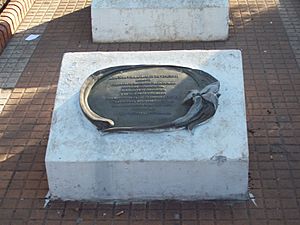Azucena Villaflor facts for kids
Azucena Villaflor (born April 7, 1924 – died December 10, 1977) was an important Argentine social activist. She helped start a human rights group called the Mothers of the Plaza de Mayo. This group searched for people who had "disappeared" during a difficult time in Argentina's history, known as the Dirty War. These people were often taken by force and never seen again.
Contents
Who Was Azucena Villaflor?
Azucena Villaflor came from a working-class family. Her mother, Emma Nitz, was 15 when Azucena was born. Her father, Florentino Villaflor, was 21 and worked in a wool factory. Azucena's family had a history of being involved in Peronism, a political movement in Argentina.
Early Life and Family
When she was 16, Azucena started working as a secretary for a company that sold home appliances. There, she met Pedro De Vincenti, who was a leader for a workers' union. They got married in 1949 and had four children together.
Starting the Mothers of the Plaza de Mayo
In November 1976, a military government took over Argentina. This government called itself the "National Reorganization Process". Eight months after this, Azucena's son, Néstor, and his girlfriend, Raquel Mangin, were taken away. They "disappeared."
Azucena immediately started looking for them. She went to government offices and tried to get help from church officials. During her search, she met other women whose family members had also disappeared.
After six months of searching with no success, Azucena decided to do something more public. On April 30, 1977, she and thirteen other mothers went to Plaza de Mayo. This is a big square in central Buenos Aires, right in front of the government building, the Casa Rosada. Azucena chose this spot because it was a very important place in Argentine history.
The police told them to "circulate," meaning not to stand still. So, the mothers decided to walk around the Plaza. Their first march was on a Saturday and wasn't very noticeable. The next one was on a Friday. After that, they decided to march every Thursday at about 3:30 p.m. This tradition continues even today. These brave women became known as the Mothers of the Plaza de Mayo.
Her Disappearance and Legacy
On December 10, 1977, which is Human Rights Day, the Mothers published a newspaper ad. It listed the names of their disappeared children. That very night, Azucena Villaflor was taken from her home by armed people.
What Happened to Her?
Reports say she was held in a secret prison camp. This camp was at the Navy Mechanics School (ESMA). It was a very harsh place.
Many years later, in 2003, a group called the Argentine Forensic Anthropology Team found the bodies of five women who had disappeared in 1977. Azucena Villaflor was one of them. The others were Esther Ballestrino, María Ponce de Bianco, Angela Auad, and Sister Léonie Duquet.
Remembering Azucena
Azucena Villaflor's remains were cremated. Her ashes were buried at the base of the May Pyramid in the middle of the Plaza de Mayo. This happened on December 8, 2005, at the end of the Mothers' 25th Annual Resistance March.
Her children who were still alive chose this spot. Her daughter Cecilia said it was because "Here [at the Plaza] is where my mother became a public figure, and here she must stay forever. She must stay for everyone."
A book about Azucena Villaflor was written by a historian named Enrique Arrosagaray in 1997. There is also a street named after her, honoring her memory and bravery.
See also
 In Spanish: Azucena Villaflor para niños
In Spanish: Azucena Villaflor para niños


